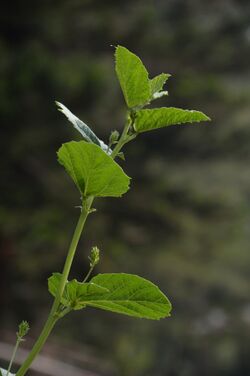Biology:Cullen corylifolium
| Cullen corylifolium | |
|---|---|

| |
| Scientific classification Error creating thumbnail: Unable to save thumbnail to destination
| |
| Kingdom: | Plantae |
| Clade: | Tracheophytes |
| Clade: | Angiosperms |
| Clade: | Eudicots |
| Clade: | Rosids |
| Order: | Fabales |
| Family: | Fabaceae |
| Subfamily: | Faboideae |
| Genus: | Cullen |
| Species: | C. corylifolium
|
| Binomial name | |
| Cullen corylifolium | |
| Synonyms[1] | |
| |
Cullen corylifolium, synonym Psoralea corylifolia,[1] (babchi) is a plant used in Indian and Chinese traditional medicine. The seeds of this plant contain a variety of coumarins, including psoralen.
Etymology
Corylifolium comes from similarity of the leaves to those of Corylus, a genus of tree in northern world regions, such as Sweden.[2]
Description
Cullen corylifolium grows 50–90 cm tall and is an annual plant. It has pale-purple flowers in short, condensed, axillary spikes. Its corolla is pale purple. Flowers one-seeded fruits. The most distinctive feature is the occurrence of minute brown glands which are immersed in surface tissue on all parts of the plant, giving it a distinctive and pleasant fragrance.[2]
Habitat and distribution
Cullen corylifolium is native to north-east tropical Africa, the southern Arabian Peninsula, and tropical and subtropical Asia, including India and Sri Lanka.[1] It was occasionally cultivated in Arabia for its supposed medicinal properties.[2]
Chemical constituents
Cullen corylifolium extract contains numerous phytochemicals, including flavonoids (neobavaisoflavone, isobavachalcone, bavachalcone, bavachinin, bavachin, corylin, corylifol, corylifolin and 6-prenylnaringenin), coumarins (psoralidin, psoralen, isopsoralen and angelicin), meroterpenes (bakuchiol, and 3-hydroxybakuchiol).[3]
Use in traditional medicine
Cullen corylifolium, or bu gu zhi in traditional Chinese medicine,[4] is an herb used as a therapy for several disorders, such as treatment of lichen planus by psoralen extract combined with sunlight exposure.[5]
References
- ↑ 1.0 1.1 1.2 1.3 "Cullen corylifolium (L.) Medik.". Plants of the World Online. Royal Botanic Gardens, Kew. http://www.plantsoftheworldonline.org/taxon/urn:lsid:ipni.org:names:489225-1.
- ↑ 2.0 2.1 2.2 G. Miller, Anthony; Morris, Miranda (1988). Plants of Dhofar. Oman. pp. 174–5. ISBN 978-071570808-8.
- ↑ "Fingerprint analysis of Psoralea corylifolia by HLPC and LC-MS". J Chromatogr B 821 (1): 67–74. 2005. doi:10.1016/j.jchromb.2005.04.008. PMID 15905140.
- ↑ Cheng, Xia (2001). Easy Comprehension of Traditional Chinese Medicine: Chinese Materia Medica, Canadian Institute of Traditional Chinese Medicine, p343.
- ↑ Atzmony, L; Reiter, O; Hodak, E; Gdalevich, M; Mimouni, D (2016). "Treatments for cutaneous lichen planus: A systematic review and meta-analysis.". American Journal of Clinical Dermatology 17 (1): 11–22. doi:10.1007/s40257-015-0160-6. ISSN 1175-0561. PMID 26507510.
Wikidata ☰ {{{from}}} entry
 |

